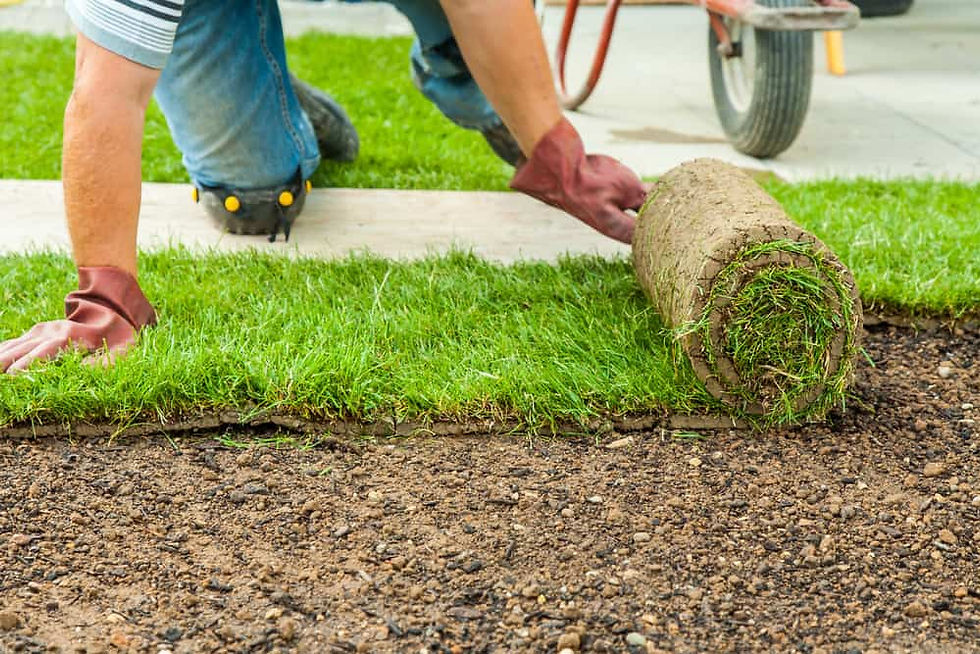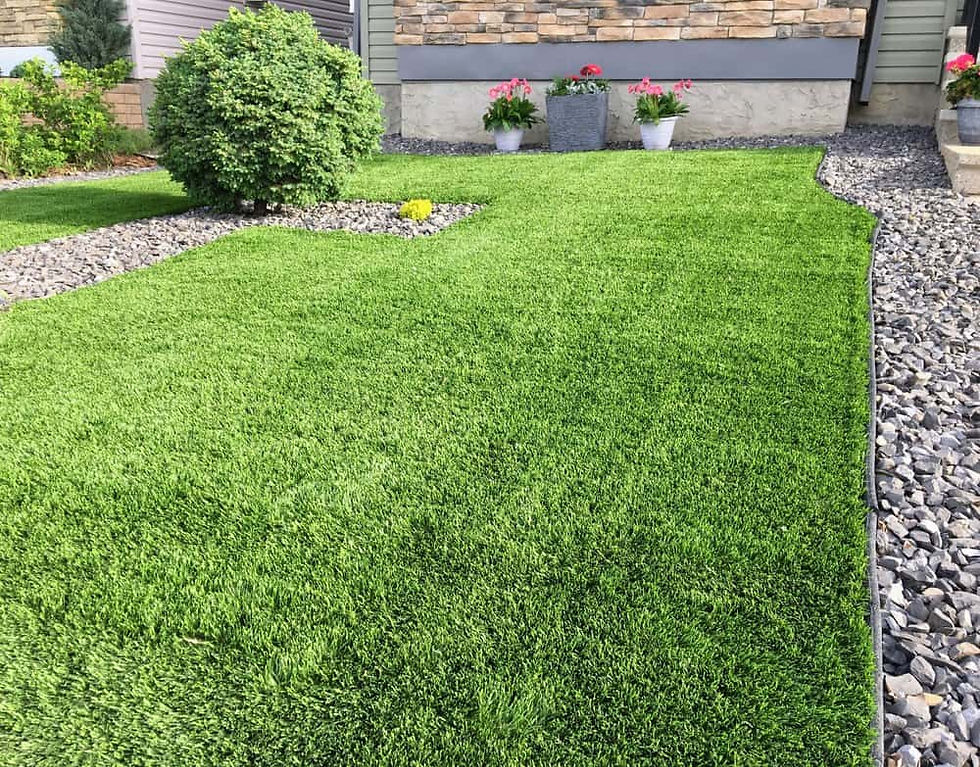Sod vs. Synthetic Turf Choosing the Right Solution for Your Lawn
- Clayton DePriest
- Apr 9, 2024
- 4 min read
When it comes to transforming your lawn, two popular options stand out: sod and synthetic turf. Both offer unique advantages and considerations, making the choice between them a crucial decision for homeowners. In this comprehensive guide, we'll explore the ins and outs of sod and synthetic turf, from installation to cost comparisons, and answer common questions to help you make an informed decision for your landscaping needs.
Understanding Sod and Synthetic Turf:
Sod, also known as turfgrass sod, refers to rolls of pre-grown grass that are installed onto prepared soil. It provides an instant green lawn and is typically made from natural grass varieties such as Bermuda, Kentucky Bluegrass, or Zoysia. On the other hand, synthetic turf, also known as artificial turf or fake grass, is made from synthetic fibers designed to mimic the look and feel of real grass. It offers a low-maintenance alternative to traditional lawns and is often used in areas where natural grass struggles to thrive.
Sod Installation: The Instant Green Solution
Sod installation offers homeowners the immediate gratification of a lush, green lawn. The process involves preparing the soil, laying the sod rolls tightly together, and ensuring proper irrigation and maintenance to facilitate root establishment. With sod, you can enjoy a mature lawn in a matter of weeks, making it an ideal choice for those seeking instant curb appeal or dealing with bare patches in their yard.

Synthetic Turf Installation: Low-Maintenance, High Appeal
Synthetic turf installation offers a hassle-free alternative to traditional grass lawns. The process involves preparing the ground, laying a base material, and installing the synthetic turf rolls or tiles. Once in place, synthetic turf requires minimal maintenance, eliminating the need for mowing, watering, and fertilizing. It provides a consistently green and pristine lawn year-round, making it particularly attractive for homeowners with busy lifestyles or limited access to water resources.

Is it Cheaper to Lay Sod or Artificial Turf?
The cost comparison between sod and artificial turf installation depends on various factors such as the size of the area, site preparation requirements, and the type of grass or turf chosen. While sod may have lower upfront costs per square foot, it requires ongoing maintenance expenses such as watering, fertilizing, and mowing. In contrast, artificial turf involves higher initial investment but offers long-term savings in terms of water bills, maintenance, and labor. Ultimately, the cost-effectiveness of each option depends on your specific needs and budget considerations.
Which is Better: Sod or Turf?
The choice between sod and turf ultimately comes down to your preferences, lifestyle, and landscaping goals. Sod provides the instant gratification of a natural lawn and can thrive in various climates with proper care. However, it requires regular maintenance and may struggle in areas with heavy foot traffic or poor soil conditions. On the other hand, synthetic turf offers year-round greenery with minimal upkeep, making it ideal for high-traffic areas or regions with water restrictions. Consider factors such as aesthetics, maintenance requirements, and long-term sustainability when deciding which option is best for your lawn.
Does Artificial Turf Attract Termites?
One common concern among homeowners considering synthetic turf is whether it attracts pests like termites. Fortunately, synthetic turf is made from materials that are not appealing to termites, making it an effective deterrent against infestations. Unlike natural grass, which can provide habitat and food sources for pests, artificial turf eliminates the risk of termite damage and reduces the need for chemical pesticides, contributing to a healthier and pest-free outdoor environment.
Is Sod the Same as Artificial Turf?
While both sod and artificial turf provide solutions for creating green lawns, they differ significantly in composition and installation methods. Sod consists of living grass plants grown on a layer of soil, which are then harvested and rolled into convenient rolls for installation. In contrast, artificial turf is made from synthetic materials such as polyethylene or polypropylene fibers stitched onto a backing material to create a grass-like appearance. While sod offers a natural and organic lawn option, artificial turf provides a low-maintenance and durable alternative with consistent aesthetics year-round.
Is Sod More Expensive Than Turf?
The cost comparison between sod and turf depends on various factors such as installation method, maintenance requirements, and long-term durability. Sod typically has lower upfront costs per square foot but requires ongoing expenses for maintenance, irrigation, and replacement. In contrast, artificial turf involves higher initial investment but offers long-term savings in terms of water conservation, reduced maintenance, and longevity. Consider your budget, lifestyle, and landscaping goals when evaluating the overall cost-effectiveness of each option for your lawn.
Why Use Turf Instead of Grass?
There are several compelling reasons to choose turf over traditional grass for your lawn:
Low Maintenance: Synthetic turf requires minimal upkeep, saving you time and effort on mowing, watering, and fertilizing.
Durability: Artificial turf is highly resilient to foot traffic, pet activity, and environmental factors, maintaining its pristine appearance year-round.
Water Conservation: Synthetic turf eliminates the need for watering, reducing water usage and promoting environmental sustainability.
Allergy-Friendly: For individuals with grass allergies, synthetic turf provides a hypoallergenic alternative that doesn't produce pollen or trigger allergic reactions.
Versatility: Synthetic turf can be installed in various outdoor spaces, including residential lawns, playgrounds, sports fields, and rooftop gardens, offering versatile landscaping solutions.
Both sod and synthetic turf offer unique benefits and considerations for homeowners seeking to enhance their outdoor spaces. Whether you prioritize instant greenery, long-term sustainability, or low maintenance, there's a solution that aligns with your landscaping goals. By weighing the factors discussed in this guide and consulting with professionals, you can make an informed decision that transforms your lawn into a beautiful and functional outdoor oasis. Whether you opt for the instant gratification of sod or the hassle-free appeal of synthetic turf, your landscape is sure to thrive with the right choice. Contact Dr Greens for Sod Installation and Synthetic Turf Installation.

Comments